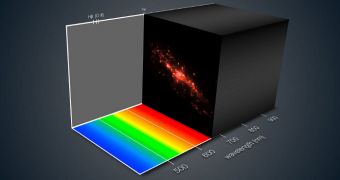Officials with the European Southern Observatory (ESO) are proud to announce that Unit Telescope 4 at the Very Large Telescope (VLT), on Cerro Paranal in Chile, has just received its first second-generation scientific instrument, the Multi Unit Spectroscopic Explorer (MUSE).
The innovative MUSE has already been tested in the lab extensively, as well as in the field. During these assessments, it focused on observing very distant galaxies, which will be its main job once it commences full scientific operations. This instrument is meant to determine the exact mechanisms of galaxy formation, thus providing us with a new understanding of how the Universe evolved.
This spectroscope is the third second-generation instrument on the VLT in general. The K-band Multi-Object Spectrograph (KMOS) asset has already been installed on Unit Telescope 1, nicknamed Antu, while the X-shooter camera has been affixed to Unit Telescope 2, Kueyen. MUSE is now installed on UT4, nicknamed Yepun.
When it begins conducting studies, the camera will focus on distant and very distant galaxies in the Universe, as well as on the brightest stars out there and other scientific targets in the distant Cosmos.
MUSE was completed by its manufacturer – and accepted by Europe – in September 2013. Shortly afterwards, it was shipped to base camp under Cerro Paranal. After undergoing a series of tests and preparations, the camera was carefully transported to the VLT site and installed on Yepun.
“It has taken a lot of work by many people over many years, but we have done it!” says Roland Bacon, principal investigator for MUSE and the leader of its science team. The expert holds an appointment with the Centre de Recherche Astrophysique de Lyon (CRAL) in France.
“It seems strange that this seven-tonne collection of optics, mechanics and electronics is now a fantastic time machine for probing the early Universe. We are very proud of the achievement – MUSE will remain a unique instrument for years to come,” he explains.
Installing MUSE on Yepun is just the latest in a series of steps meant to finally configure UT4 into a fully-adaptive telescope, capable of using adaptive optics (AO) capabilities to correct distortions caused in incoming light beams by Earth's atmosphere.
In addition to CRAL, the MUSE collaboration also includes the Leibniz-Institut für Astrophysik Potsdam (AIP), Institut für Astrophysik Göttingen (IAG), both in Germany, the Institute for Astronomy ETH Zurich, in Switzerland, L'Institut de Recherche en Astrophysique et Planétologie (IRAP) in France, the Nederlandse Onderzoekschool voor de Astronomie (NOVA), in the Netherlands, and ESO.
“A muse is there to inspire. Indeed, MUSE has inspired us for many years and will continue to do so. No doubt many astronomers from all over the world will also be charmed by our MUSE,” Bacon says.

 14 DAY TRIAL //
14 DAY TRIAL //